Ditapis dengan
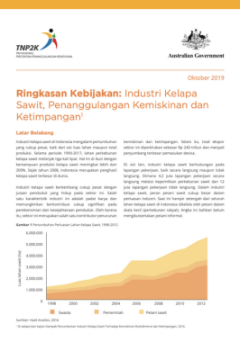
Ringkasan Kebijakan: Industri Kelapa Sawit, Penanggulangan Kemiskinan dan Ket…
Pandemi Covid-19 berdampak pada berbagai sektor, dari kesehatan hingga sosial-ekonomi, tak terkecuali ketenagakerjaan. Dalam jangka pendek, dampaknya pada kesehatan ditunjukkan dengan angka kematian korban di Indonesia yang mencapai 8,9 persen. Pada ekonomi, pandemi ini menyebabkan anjloknya aktivitas perekonomian domestik, yang tidak menutup kemungkinan akan menurunkan kesejahteraan masyarakat…
- Edisi
- -
- ISBN/ISSN
- -
- Deskripsi Fisik
- PDF, 8 Halaman
- Judul Seri
- Policy Brief
- No. Panggil
- 333.95 TNP.R
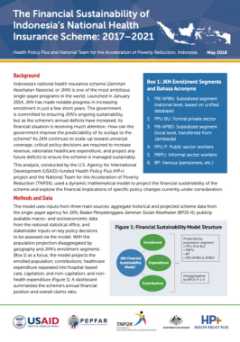
The Financial Sustainability of Indonesia’s National Health Insurance Schem…
Indonesia continues to make considerable progress to increase the membership of its social insurance program especially for its wage recipients (pekerja penerima upah/PU) who are mostly formal sectors workers. Unfortunately, coverage for the non-wage recipients/pekerja bukan penerima upah/BPU who mostly work at the informal sector workers are still very low (about 2.4 million active members as …
- Edisi
- 1
- ISBN/ISSN
- -
- Deskripsi Fisik
- PDF, 3 Halaman
- Judul Seri
- Policy Brief
- No. Panggil
- 368.4 TNP.T
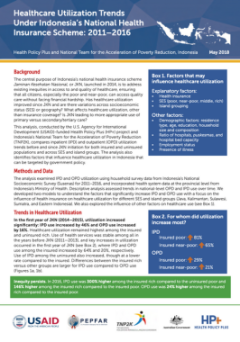
Healthcare Utilization Trends Under Indonesia’s National Health Insurance S…
The central purpose of Indonesia’s national health insurance scheme Jaminan Kesehatan Nasional, or JKN, launched in 2014, is to address existing inequities in access to and quality of healthcare, ensuring that all citizens, especially the poor and near-poor, can access quality care without facing financial hardship. Has healthcare utilization improved since JKN and are there variations across…
- Edisi
- 1
- ISBN/ISSN
- -
- Deskripsi Fisik
- PDF, 2 Halaman
- Judul Seri
- Policy Brief
- No. Panggil
- 368.3 TNP.H
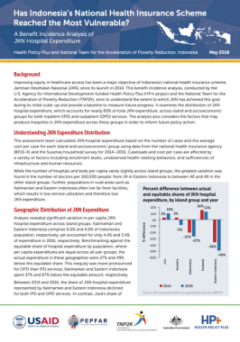
Has Indonesia’s National Health Insurance Scheme Reached the Most Vulnerabl…
Improving equity in healthcare access has been a major objective of Indonesia’s national health insurance scheme, Jaminan Kesehatan Nasional (JKN), since its launch in 2014. This benefit incidence analysis, conducted by the U.S. Agency for International Development-funded Health Policy Plus (HP+) project and the National Team for the Acceleration of Poverty Reduction (TNP2K), aims to under…
- Edisi
- 1
- ISBN/ISSN
- -
- Deskripsi Fisik
- PDF, 2 Halaman
- Judul Seri
- Policy Brief
- No. Panggil
- 363.8 TNP.H
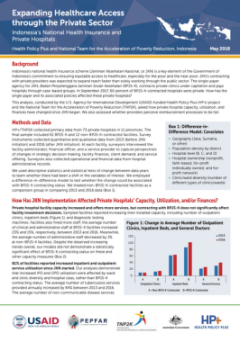
Expanding Healthcare Access through the Private Sector Indonesia’s Nation…
Indonesia’s national health insurance scheme (Jaminan Kesehatan Nasional, or JKN) is a key element of the Government of Indonesia’s commitment to ensuring equitable access to healthcare, especially for the poor and the near-poor. JKN’s contracting with private providers was expected to expand reach faster than solely working through the public sector. The single-payer agency for JKN, B…
- Edisi
- 1
- ISBN/ISSN
- -
- Deskripsi Fisik
- PDF, 2 Halaman
- Judul Seri
- Policy Brief
- No. Panggil
- 368 USA.E

Poverty Brief Poverty And The Economy November 2013
After a deflation in the Consumer Price Index (CPI) in September 2013 (-0.3 percent), the inflation rate in October 2013 was 0.09 percent and resulted in year-on-year inflation of 8.32 percent and year-to-date inflation of 7.66 percent. Food products which constituted the biggest contribution to inflation in the last several months experienced deflation both in September (-2.7 percent) and i…
- Edisi
- -
- ISBN/ISSN
- -
- Deskripsi Fisik
- PDF, 4 Halaman
- Judul Seri
- Policy Brief
- No. Panggil
- 362.5 TNP.P
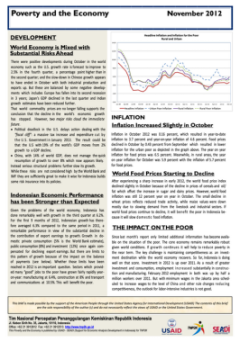
Poverty and the Economy November 2012
There were positive developments during October in the world economy such as the U.S. growth rate is forecast to improve to 2.5% in the fourth quarter, a percentage point higher than in the second quarter; and the slow-down in Chinese growth appears to have ended in October with both industrial producion and exports up. But these are balanced by some negaive developments which includes Europe h…
- Edisi
- 1
- ISBN/ISSN
- -
- Deskripsi Fisik
- PDF, 2 Halaman
- Judul Seri
- Policy Brief
- No. Panggil
- 362.5 USA.P
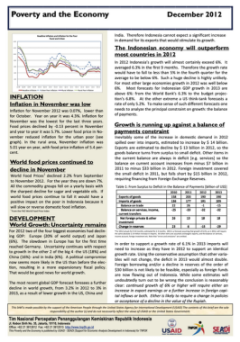
Poverty and the Economy December 2012
Inflation for November 2012 was 0.07%, lower than for October. Year on year it was 4.3%. InflaƟon for November was the lowest for the last three years. Food prices declined by ‐0.13 percent in November and year to year it was 5.7%. Lower food price in No‐ vember reduced inflaƟon for the urban poor (see graph). In the rural area, November inflaƟon was 5.01 year on year, with food pric…
- Edisi
- 1
- ISBN/ISSN
- -
- Deskripsi Fisik
- PDF, 2 Halaman
- Judul Seri
- Policy Brief
- No. Panggil
- 362.5 USA.P
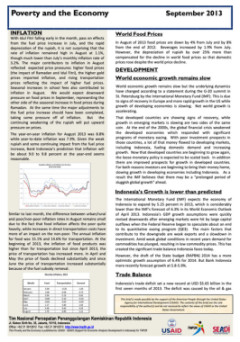
Poverty and the Economy September 2013
With Idul Fitri falling early in the month, pass on effects from the fuel price increase in July, and the rapid depreciation of the rupiah, it is not surprising that the rate of inflation remained high in August at 1.1%, though much lower than July’s monthly inflation rate of 3.2%. The major contributors to inflation in August reflected expected price pressures: higher food prices (the impact…
- Edisi
- 1
- ISBN/ISSN
- -
- Deskripsi Fisik
- PDF, 2 Halaman
- Judul Seri
- Policy Brief
- No. Panggil
- 362.5 USA.P
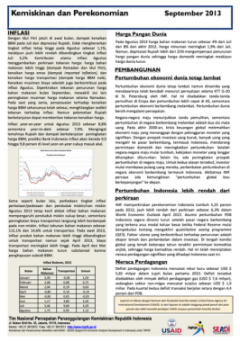
Kemiskinan dan Perekonomian September 2013
Dengan Idul Fitri jatuh di awal bulan, dampak kenaikan BBM pada Juli dan depresiasi Rupiah, tidak mengherankan tingkat inflasi tetap tinggi pada Agustus sebesar 1,1%, meskipun jauh lebih rendah dibandingkan tingkat inflasi Juli 3,2%. Kontributor utama inflasi Agustus menggambarkan perkiraan tekanan harga: harga bahan makanan lebih tinggi (dampak Ramadan dan Idul Fitri), kenaikan harga emas (dam…
- Edisi
- -
- ISBN/ISSN
- -
- Deskripsi Fisik
- PDF, 2 Halaman
- Judul Seri
- Policy Brief
- No. Panggil
- 362.5 USA.K

 Karya Umum
Karya Umum  Filsafat
Filsafat  Agama
Agama  Ilmu-ilmu Sosial
Ilmu-ilmu Sosial  Bahasa
Bahasa  Ilmu-ilmu Murni
Ilmu-ilmu Murni  Ilmu-ilmu Terapan
Ilmu-ilmu Terapan  Kesenian, Hiburan, dan Olahraga
Kesenian, Hiburan, dan Olahraga  Kesusastraan
Kesusastraan  Geografi dan Sejarah
Geografi dan Sejarah